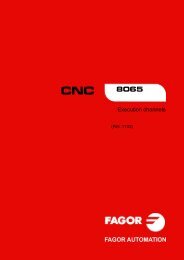CNC 8055 - Operating manual (MC option) - Fagor Automation
CNC 8055 - Operating manual (MC option) - Fagor Automation
CNC 8055 - Operating manual (MC option) - Fagor Automation
You also want an ePaper? Increase the reach of your titles
YUMPU automatically turns print PDFs into web optimized ePapers that Google loves.
6.<br />
EXECUTION AND SIMULATION<br />
Graphic representation<br />
<strong>CNC</strong> <strong>8055</strong><br />
<strong>CNC</strong> <strong>8055</strong>i<br />
·<strong>MC</strong>· OPTION<br />
SOFT: V01.3X<br />
·156·<br />
ISO<br />
<strong>Operating</strong> <strong>manual</strong><br />
In the conversational mode of the <strong>CNC</strong>, it is possible to generate an ISO-coded program with some<br />
basic G functions as well as M and T functions from an operation (cycle) or on a part-program.<br />
To enable this feature, set general machine parameter ISOSIMUL (P183) with a value other than<br />
zero. This parameter identifies the number of the ISO program generated in user RAM memory.<br />
The program generated from the conversational program is an ISO-coded program created in RAM<br />
memory. This program may be later edited, copied or executed at the <strong>CNC</strong> itself.<br />
To generate the ISO program, use the simulation in conversational mode through the "GRAPHICS"<br />
key. This can be done in a whole program on the PPROG screen or in any of the particular TC or<br />
<strong>MC</strong> cycles.<br />
Once inside the graphic simulation screen, the ISO generation maybe selected using the <br />
softkey. Then, pressing [CYCLE START] will generate the program defined by machine parameter<br />
ISOSIMUL (that will only contain ISO instructions) while it simulates it graphically.<br />
When generating that program, parametric programming, rounding (G36), tangential entry (G37),<br />
tangential output (G38), chamfer (G39) and path tangent to previous path (G8) are resolved and<br />
generated only using G1, G2 and G3 blocks.<br />
If the program already exists, it will be deleted without requesting confirmation. If the generated<br />
program exceeds the available user memory, the <strong>CNC</strong> will issue the corresponding error message,<br />
but it will keep in memory the portion of the ISO program generated so far.<br />
Description of the functions used to generate an ISO-coded program:<br />
The ISO-coded program is mainly generated to control axes. It provides information of the moving<br />
conditions and indications on feedrate using the following set of functions<br />
G functions: Motion preparatory functions to determe the geometry and work conditions.<br />
Function Meaning<br />
G2 (G3) G6 X Y I J In the circular interpolation, the center will be programmed with respect to<br />
the origin, not referred to the starting point of the circle.<br />
Rigid tapping cycles G84 (mill) and G86 (lathe) only generate the equivalent ISO block.<br />
"F" and "S" functions: Functions to control the feedrate of the axes and the spindle turning<br />
speed.<br />
T and D functions: Tool control functions.<br />
If the T function has an associated subroutine, the blocks of this subroutine are ignored when<br />
generating the program set by g.m.p. ISOSIMUL (P183).<br />
M function: Complementary or auxiliary functions.<br />
If the M functions have an associated subroutine, the blocks of this subroutine are ignored when<br />
generating the program set by g.m.p ISOSIMUL (P183).

















